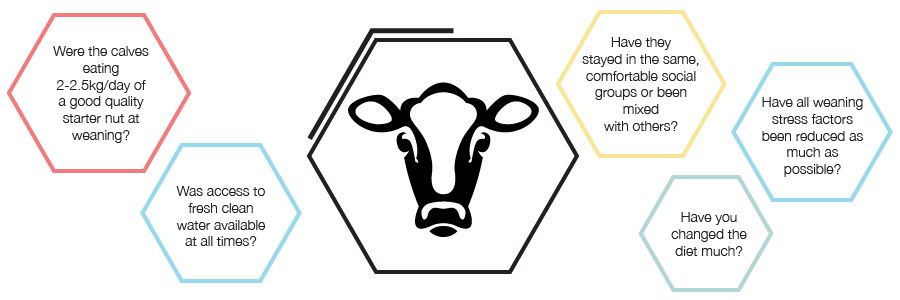Performance of calves can only be monitored if the time is taken to measure, directly or indirectly.
Direct measures:
These are done “at the time”, for example measuring heights/weights using a weightape (or electronic scales if available) at a point in time.
Indirect measures
Using retrospective data such as service and calving age/weights to determine performance.
Reduced calving age from one year to the next may suggest improved calf and heifer rearing; however, it is months later when we can make these assumptions. If a heifer is first served at 18 months old, it can be assumed that there are improvements to be made to allow future heifers to reach service weight earlier. But it is difficult at this point to then determine at which stage of rearing that this heifer didn’t meet her targets and fell behind.
The more accurate, and instant, measure of progress is to weigh calves and heifers at stages through their rearing process to continuously assess whether they are on track to hitting the targeted 800g daily live weight gain, only through the data collected can you then decide if changes need to be made to your current rearing protocols.
For example, if a dairy heifer has not doubled her birth weight by weaning it is highlighted there and then allowing for decisions to be made as to whether to push her on or remove her from the herd.
If it appears that a number of animals (as opposed to an individual) are not reaching their weaning target, it may be worth focusing on the following:


If weights are looking great at weaning but seem to drop off in the following months, consider:


Carrying animals that are continually below their targets can be a real cost to any business, and breeding replacements from heifers that have always struggled can get farms into a vicious cycle of producing calves that may be prone to under-performing! So, measuring not only assists in highlighting the weak areas for farms to focus on, but can also help in breeding decisions – breed replacements from the best (the girls that have always been on track)!
Setting long-term targets is important; research has repeatedly found calving heifers between 22-24 months enables them to be the most healthy and profitable animals.
In summary, setting targets and knowing what your long-term goals are is key to success. Monitoring progress of the animals is the only way to know if targets are being met and allow for problem solving if not.
As more coronavirus restrictions are relaxed throughout the UK the Wynnstay Calf & Youngstock Team can help measure performance through growth rate monitoring on farm. Setting targets, long-term goals and measuring allows you to identify gaps between targets and reality and means that we can go on to quantify improvements.










